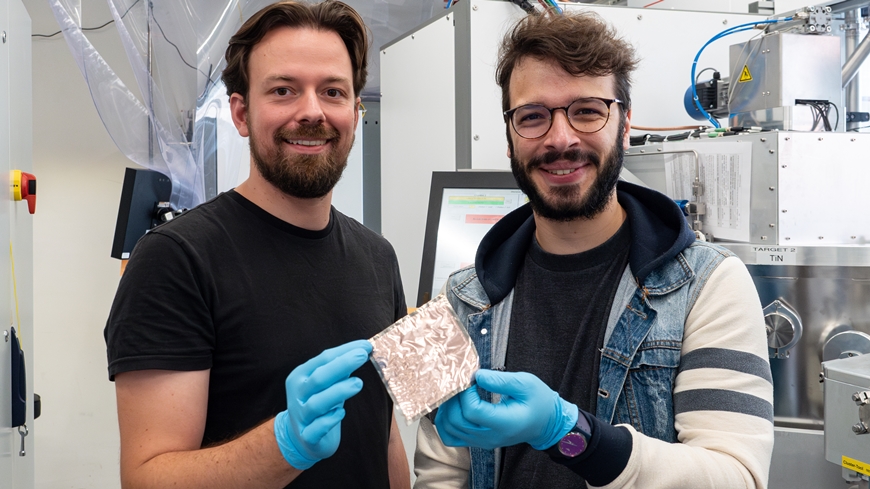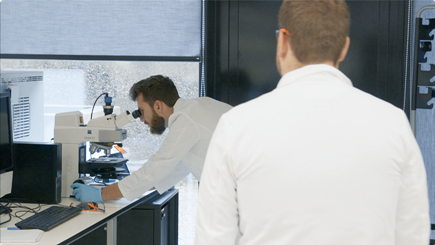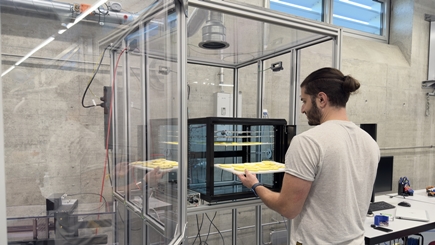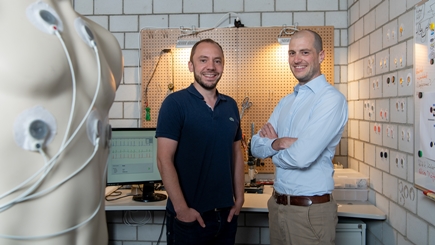Technology transfer
Empa spin-offs: Innovation at its best
If no industrial partner can be found for a promising new technology, researchers frequently become entrepreneurs themselves. Spin-offs are young companies that emerge directly from Empa's research. They develop products and services that do not yet exist – as these four examples show.

BTRY: Thinner, faster, better
Lithium-ion batteries are currently our most advanced battery technology, but they do have some weaknesses. They lose capacity with every cycle, charge relatively slowly and only work well in a narrow temperature range. Moritz Futscher and Abdessalem Aribia are convinced they can do better. Together, the two former Empa researchers have founded the spin-off BTRY, which is developing a completely new type of thin-film battery. Not only is it safer and more durable than conventional lithium-ion batteries, it is also much more environmentally friendly to manufacture and can be charged and discharged in just one minute. Their vision has been well received: Since its founding last year, BTRY has already completed a successful financing round and made it to the third stage of the Venture Kick program, as well as earning a place among the Top 100 Swiss Start-ups. What began with prototypes of just a few millimeters is now a cell measuring around ten by ten centimeters that is still as thin as a hair. The long-lasting and fast thin-film batteries are in particular demand in the fields of medical technology, sensor technology and consumer electronics.
anavo medical: Improved wound healing thanks to nanoparticles

Poorly healing wounds are a major burden for those affected and an increasing cost factor for the healthcare system. The start-up anavo medical aims to remedy this with innovative materials based on nanoparticles. The healing nanoparticles are to be used, for example, as a spray for chronic wounds caused by diabetes or as an aqueous solution for wound healing disorders after operations. The metal oxide nanoparticles work by reducing inflammation and killing bacteria. "What's more, the nanoparticles also stimulate the body's own healing processes by promoting the formation of healthy tissue," says anavo co-founder Tino Matter. Another advantage of the technology developed by researchers at Empa's Particles-Biology Interactions laboratory in St. Gallen in collaboration with the Nanoparticle Systems Engineering Lab at ETH Zurich is that it is based on inexpensive materials that can be produced on a large scale. For this innovative achievement in technology transfer, anavo received the Empa Innovation Award and the Best Swiss Nanotech Startup Award, among others. Following promising laboratory results, the first clinical trials with patients are planned for the near future.
Ionic Wind Technologies: Energy-efficient cooling thanks to ionic wind

Data centers consume vast amounts of energy – around 40 percent of it for cooling microprocessors alone. Novel cooling methods using ionic wind could drastically reduce this. These devices use electrostatic fields to convert electrical current directly and efficiently into a stream of air. The low speeds of the generated airflow have so far prevented widespread use. Now the multi-award-winning Empa spin-off Ionic Wind Technologies has achieved a breakthrough: Their novel airflow amplifier accelerates ionic wind much more strongly than before – thanks to new types of electrodes combined with a flow-optimized housing shape. If, for instance, conventional fans in data centers were replaced by their patented technology, up to 60 percent of cooling energy could be saved. According to spin-off founder Donato Rubinetti, the technology developed is suitable for industries that rely on cooling systems, drying processes and air purification. "I see potential wherever air needs to be moved with a small pressure difference, for example in the drying of food, which we have already done and know very well. In future, however, it will also be used primarily for cooling computers, servers and data centers."
Nahtlos: Cool clothing

Summer heat is particularly hard on people whose body's own temperature regulation is limited, for instance people with paraplegia, who are unable to sweat in the affected areas of their body. This is where the developers of the St. Gallen medtech start-up Nahtlos come in with their cooling garments: Equipped with a semi-permeable textile layer with a water reservoir, the clothing uses the cooling effect of evaporating water. "The cooling vest draws heat from the skin in this process, which provides relief from overheating," says José Näf, co-founder of the Empa spin-off. "There is great demand for products of this kind – also for use in heat-intensive working environments, such as road construction or production facilities," says the neo-entrepreneur. The team led by founding partner and former Empa researcher Michel Schmid is also working on further developing the textile ECG electrodes "Duratrode", which have already been successfully launched on the market, for high-volume production.
Technology transfer
How do innovations get out of the lab and into the wider world? There are different ways, summarized under the term technology transfer. At Empa, technology transfer takes many different forms – be it through direct industry cooperation, Innosuisse-funded projects or by founding start-ups. If these endeavours are ultimately successful, they result in innovative products and solutions that make our world a little bit better.
Read the latest EmpaQuarterly online or download the PDF version.
-
Share






